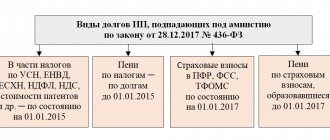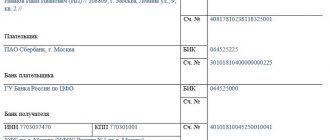Legal aspects of determining the procedure for paying taxes and fees
Timely payment of taxes and fees is one of the main obligations of the tax payer, failure to fulfill which entails bringing the violator to legal liability, therefore the issues of the procedure and conditions for making the relevant payments, calculating their amounts and the timing of this operation are quite relevant.
The procedure for paying taxes and fees, along with the subject and object of taxation, the tax base and the tax rate, is one of the fundamental elements of the taxation system, on the basis of which the tax policy of the Russian Federation is implemented.
Rules for filling out a payment order
The procedure for paying taxes by a legal entity or entrepreneur involves several stages. First, the accountant calculates the amount of payment to the budget, then generates a payment order - an instruction to the bank to write off funds from the organization’s current account to the supplier or budget authorities.
How quickly the bank can process the payment, and the government agency can identify the received funds, depends on how quickly the payment order is filled out. Errors in payments are money lost in transit that will not arrive in the budget on time or will arrive but end up in unidentified receipts. This means that the company risks receiving fines and penalties for late payment of taxes.
To prevent this from happening, read our instructions “How to fill out a payment order in 2021 - sample”.
One of the most important information in the payment order for the payment of taxes is the KBK. Their values applied in 2017-2018 can be found in this article.
Read about what the details for paying tax payments in Moscow have become since 2021 in the publication.
From 2021, payments for insurance premiums must be processed with the new BCC. Read more about changes in payment of insurance premiums in the following publications:
- “The table with the BCC from the tax authorities will help you avoid making mistakes in paying contributions in 2021”;
- “Look at how the details for contributions will change from 2017”;
- “What is the deadline for paying insurance premiums in 2017?”;
- “What taxes to pay to funds in 2021 - table”.
However, the rules for paying contributions to the Social Insurance Fund for accident insurance have not changed, and payment orders for them are issued in the same way as in 2021.
Fundamental principles used in the payment of taxes and duties
The procedure and form of payment of taxes and fees, obligations and rights of payers are regulated by Art. 58 Tax Code of the Russian Federation.
In accordance with the requirements of this rule of law:
- Tax payment made in the proper form is made once and in full. The law allows the transfer of preliminary payments, but they do not have the basic properties of a tax, therefore, violation of the timing of their implementation and the procedure for calculation is not a sufficient basis for bringing the violator to legal liability, in particular administrative liability;
- the taxpayer (tax agent) or his authorized representative must transfer the entire amount of the tax or fee within the period established by the relevant rules of law;
- compliance with the procedure for calculating and paying preliminary payments established by the Tax Code of the Russian Federation is mandatory for tax payers;
- Payments can be made in cash or by non-cash form;
- the procedure for calculating and paying each specific tax is established by the Tax Code of the Russian Federation, as well as by the tax laws of individual constituent entities of the Russian Federation and by-laws of municipal authorities.
Legal relations that arise after the correct calculation and payment by the taxpayer of mandatory taxes and fees, which provides for the proper fulfillment of tax obligations, are regulated by budgetary acts of lawmaking.
Excise taxes
The main regulatory document regulating the procedure for calculating and paying excise taxes is the Tax Code of the Russian Federation. From 01/01/2000 Chapter 22 of the Tax Code of the Russian Federation “Excise taxes” was introduced
The accrual and payment of excise taxes are reflected similarly to VAT in the “Excise taxes” subaccount of account 68 “Calculations for taxes and fees”.
Organization of accounting for accrual and transfer of personal income tax to the budget
To calculate this tax, accounting must have information about the number of dependents for each employee. Since 2001 a single rate has been established = 13% of the total tax base.
Taxable income is determined by deducting from the accrued salary amount the amount of deductions established by the Tax Code differentially and for each dependent.
The accrual of personal income tax is reflected in one of the entries (depending on the situation):
— Debit 70 Credit 68 subaccount “Income tax for individuals” - income tax is withheld from amounts accrued to the company’s employees;
— Debit 75 Credit 68 subaccount “Income Tax for Individuals” - income tax is withheld from the amounts of dividends paid to the founders (participants), if they are not employees of your company;
— Debit 76 Credit 68 subaccount “Income tax for individuals” - income tax is withheld from amounts paid to individuals who are not on the staff of your company.
So : D70 K68/2 - tax accrued, D68/1 K51 - tax transfer.
Standard tax deductions:
- 400 rubles - to an employee for each month of the tax period, with accumulated total income since the beginning of the year less than 40,000 rubles. (canceled);
- First and second child - 1,400 rubles - for each month of the tax period, with accumulated total income from the beginning of the year less than 280,000 rubles. for each child under 18 years of age, as well as students under 24 years of age;
— Third and each subsequent child – 3,000 rubles;
- If the mother is single - 6000, regardless of the age of the other children;
— Disabled child under 18 years old – 3,000 rubles;
— Disabled student of group I or II under 24 years old – 3000 rubles;
— The opportunity has been retained for one parent to receive a double deduction if the second parent has written an application for refusal of deductions.
Organizational property tax.
The tax base is calculated as the average annual value of the property (based on the residual value).
Tax rate - 2.2%
CC = (OS1 + OSn + 1)/n + 1, where
СС – average annual cost, rub.
OS1 – residual value for January;
OSn+1 - residual value as of the 1st day of the next reporting period, rub.;
n – number of months in the reporting period
Property tax assessed:
— Debit 91/2 Credit 68 subaccount “Calculations for property tax”;
— D68/1K51 — tax transfer.
Transport tax
When accruing, the following entries are made in accounting:
Debit 20 (25, 26, 44) Credit 68 subaccount “Calculations for transport tax” - transport tax is charged (depending on the purpose of using the vehicle).
In trading companies, transport tax is calculated by posting:
— Debit 44 Credit 68 subaccount “Calculations for transport tax” — transport tax accrued;
— Fines and penalties for transport tax have been accrued:
— Debit 99 Credit 68 subaccount “Calculations for transport tax”
— D68/1K51 — tax transfer.
Methods of paying taxes and fees and features of their implementation
The Tax Code of the Russian Federation establishes several methods of collecting tax, which include:
- payment of tax based on the declaration;
- collection of tax payment from the source of income;
- cadastral method of collecting tax payments;
- collection of tax at the time of sale of income;
- fulfillment of the obligation to pay tax in the process of using property: both movable and immovable.
Let's look at some methods in more detail.
1. Payment of the tax fee according to the declaration.
The tax payment is collected on the basis of the declaration.
The use of this method implies the obligation of the taxpayer to provide the relevant tax authority with information about income received for a certain period.
Information on the basis of which tax is calculated must be submitted in the proper form and within the prescribed period. After the taxpayer has fulfilled his obligation to pay taxes, the body that accepted the payment must provide the payer with a payment notice.
It should be noted that the method of fulfilling the obligation to pay taxes and fees through a declaration is not effective enough, due to the irresponsibility of some citizens and the desire of unreliable taxpayers to evade fulfillment of the obligation. In addition, analysis and processing of the data presented in the declaration requires considerable effort and time.
2. Payment of tax at source of income.
This method is characterized by the following tax collection procedure: the tax payment is withheld from the income of individuals until it becomes their property.
That is, the tax payment is made automatically, which makes it more efficient, unlike the previous method.
3. Cadastral method.
The cadastral method of collecting tax is implemented through the use of cadastral registers (house, land, property, trade and others), containing lists of typical objects of taxation, which are classified according to external characteristics. The cadastral method allows you to determine the average profitability of a particular taxable object.
This method is characterized by the establishment of fixed deadlines, before the expiration of which the taxpayer is obliged to make payments. For example, property tax for individuals must be paid in equal parts in September and October, before the 15th of each month.
Transfer of taxes. How to prepare payment documents
On approval of the Rules for indicating information in the fields of settlement documents for the transfer of taxes, fees and other payments to the budget system of the Russian Federation
Order of the Ministry of Finance of the Russian Federation dated November 24, 2004 No. 106n, registered with the Ministry of Justice of the Russian Federation on December 14, 2004 No. 6187
From January 1, 2005 the following
come into force:
– Rules for specifying information identifying the payer and recipient of funds
, in settlement documents for the transfer of taxes, fees and other payments to the budget system of the Russian Federation;
– Rules for specifying information identifying a payment
, in settlement documents for the transfer of taxes and fees and other payments to the budget system of the Russian Federation,
administered by tax authorities
;
– Rules for specifying information identifying a payment
, in settlement documents
for the transfer of customs and other payments from foreign economic activity
;
– Rules for specifying information identifying a payment
, in settlement documents for the transfer
of other payments
to the budget system of the Russian Federation;
– Rules for indicating information identifying the person or body that issued the settlement document
for the transfer of taxes, fees and other payments to the budget system of the Russian Federation.
Taxpayers (payers of fees), tax agents, tax collectors or payers of other payments - legal entities, individual entrepreneurs, private notaries, lawyers who have established law offices, heads of peasant (farm) households and other individuals draw up settlement documents in accordance with the rules established for these categories of payers
.
Rules
indication of information identifying the payer and recipient of funds in settlement documents for the transfer of taxes, fees and other payments to the budget system of the Russian Federation, and
Rules
for indicating information identifying the payment in settlement documents for the transfer of taxes and fees and other payments to the budget system of the Russian Federation
have remained virtually unchanged
compared to those in force in 2004 .
Changes
, mainly concern
individuals
.
So, in the “Payer” field the following is entered:
– for individual entrepreneurs
- last name, first name, patronymic and in brackets - individual entrepreneur;
– for private notaries
– last name, first name, patronymic and in brackets – notary;
– for lawyers who have established law offices
, – last name, first name, patronymic and in brackets – lawyer;
– for heads of peasant (farm) households
– last name, first name, patronymic and in brackets – peasant farm;
– for other individuals
– last name, first name, patronymic and place of residence of the individual.
The place of residence of an individual in the “Payer” field is not filled in
when indicating
in field 108
the value of the
“Document Index”
from the notification of an individual in the approved form, filled out for the taxpayer by the tax authority.
Legal entities indicate the name of the legal entity - organization, its branch or separate division.
In field 106
indicate the payment basis indicator, which has 2 digits.
It has been established that the value "BF"
– current payments of individuals - bank clients (account holders), paid from their bank account.
As before, field 108 indicates the document number
, which, depending on the value of the payment basis indicator, can take the following form if the payment basis indicator has the value:
“TR”
– number of the tax authority’s request for payment of taxes (fees);
“RS”
– number of the decision on installment plan;
“FROM”
– number of the decision on deferment;
“RT”
– number of the decision on restructuring;
“PR”
– number of the decision to suspend collection;
“VU”
– number of the case or material considered by the arbitration court;
“AP”
– number of the inspection report;
“AR”
– the number of the enforcement document and the enforcement proceedings initiated on the basis of it.
It has been established that when a taxpayer - an individual - a bank client (account holder) fills out a settlement document for payment of tax payments in field 108
the value of the “Document Index” detail is indicated from the notification of an individual in the approved form, filled out for the taxpayer by the tax authority, and in its absence, the number of another document specified in this paragraph, on the basis of which the settlement document is filled out, is indicated.
When a taxpayer - an individual - a bank client (account holder) fills out a settlement document for payment of tax payments based on a tax return, a zero (“0”) is entered in field 108
.
In field 109
The date of the document is indicated.
When a taxpayer - an individual - a bank client (account holder) fills out a settlement document for payment of tax payments based on a tax return in field 109
the date of submission of this declaration to the tax authority or, when sending a tax declaration by mail, the date of sending the postal item is indicated.
Field 110 indicates the payment type indicator, which has two signs.
Additional new payment type values have been set
:
“PL”
– payment payment;
“GP”
– payment of duty;
“VZ”
– payment of the fee.
It is clarified that the presence of blank fields in the payment document is not allowed
.
Obligation of taxpayers to make advance payments
In some cases, tax law establishes the taxpayer’s obligation to make an advance tax payment, the so-called advance payment.
The need to make an advance payment is justified by the need to ensure uniform filling of the budget, which is required to avoid a cash gap.
Features related to the payment of advance payments:
- the procedure for paying the advance payment is similar to that provided for paying the tax itself;
- the obligation to pay the advance payment is considered properly fulfilled if it is fulfilled in the manner prescribed by law;
- Incorrect calculation of the amount of the advance payment and violation of the procedure for its payment are not grounds for bringing the payer to legal liability due to improper implementation of tax legislation.
Responsibilities of representatives of local administration and postal organizations of the Russian Federation
In accordance with paragraph 4, paragraph 58 of the Tax Code of the Russian Federation, postal organizations and local administration bodies must:
1. Accept and promptly transfer amounts of money, the main purpose of which is the payment of taxes and fees, to the budget of the Russian Federation. It should be noted that the collection of fees by the above-mentioned authorities for accepting funds to pay taxes is not provided for by law;
2. Keep records of funds transferred to the budget of the Russian Federation to pay taxes;
3. Ensure that the taxpayer (tax agent) who paid the tax is issued a document confirming the fulfillment of the obligation properly. As a rule, after paying the tax, the payer receives a corresponding receipt;
4. At the request of tax authorities, provide information related to the transfer (calculation) of funds by a taxpayer or tax agent to pay taxes to the state budget.
Law, theory and concept of law
1. Payment of a tax ( fee ) is made voluntarily or compulsorily. When paying a tax (fee) voluntarily, it is done: • as a one-time payment of the entire tax amount; • in installments (by paying advance payments during the tax period, at the end of which recalculation is made). The specific procedure for paying tax is established for each tax. For example, ch. 22 “Excise taxes” of part two of the Tax Code of the Russian Federation provides for an advance procedure for collecting excise taxes in the form of the sale of excise stamps or special regional stamps for excisable goods subject to mandatory labeling. The procedure for paying federal taxes is established by the Tax Code of the Russian Federation, regional taxes - by the laws of the constituent entities of the Russian Federation, local taxes - by regulatory legal acts of representative bodies of local government in accordance with the Tax Code of the Russian Federation . 2. Taxes ( fees ) are paid in cash or non-cash form. Payment of tax in non-cash form is made by submitting a payment order to transfer the amount of tax from the taxpayer’s bank account to the credit institution in which this bank account is opened. The procedure for taxpayers to issue payment orders for the transfer of tax payments is regulated by a joint order of the Ministry of Finance of the Russian Federation and the Ministry of Taxes of the Russian Federation dated February 29, 2000 No. 21n, AP-3-25/82 (harm, dated October 1, 2001). Tax payment in cash order , through the cash desk of a village or town local government, or through a tax collector. Fulfilling the obligation to pay tax in non-monetary form (for example, by transferring goods to the state or performing any work for state needs) is prohibited. 3. There are three main methodological methods of paying tax : by declaration; at the source of income payment; cadastral method of tax payment. When paying tax according to the declaration , the taxpayer is obliged to submit a tax declaration completed in the prescribed manner to the tax authority within the prescribed period. The declaration contains information about income received and expenses incurred, sources of income, tax benefits and
the calculated amount of tax, as well as other legally significant information for taxation. When paying tax at the source of payment of income , the taxpayer receives part of the income minus the tax calculated and withheld by the accounting department of the enterprise or the entrepreneur making the payment of income (wages, amounts of material incentives, etc.). The cadastre is a register that establishes a list of typical objects (land, income, etc.), classified according to external characteristics, and determines the average profitability of the taxable object. 4. The obligation to pay taxes ( fees ) is fulfilled in the currency of Russia - Russian rubles. Foreign organizations and individuals who are not tax residents of the Russian Federation . 5. The deadlines for payment of taxes ( fees ) are established and changed by regulatory legal acts on taxes and fees in relation to each tax (fee). The deadline for paying the tax is determined by a calendar date or the expiration of a period of time calculated in years, quarters, months, weeks and days, as well as an indication of an event that must occur or occur, or an action that must be performed. The taxpayer must pay the tax on the due date or (if so desired) ahead of schedule. If this rule is violated, the taxpayer must pay penalties for late tax payment. An unpaid or incompletely paid amount of tax within the prescribed period is an arrears, the presence of which is the basis for the forced collection of the corresponding amounts of money from the taxpayer by the tax authority. 6. A tax ( fee ) not recognized as paid in the following cases : the taxpayer withdraws a payment order4 to transfer the amount of tax to the budget (non-budgetary fund); the bank returning the payment order to the taxpayer to transfer the tax amount to the budget (extra-budgetary fund); when, at the time the taxpayer submits an order to pay the tax to the bank, there are other unfulfilled claims against the account, which, in accordance with the civil legislation of the Russian Federation, are fulfilled as a matter of priority, and the taxpayer does not have sufficient funds in the account to satisfy all the claims.
Determination of the procedure and deadlines for paying different types of taxes and fees
Calculation and payment of specific taxes are carried out in the manner prescribed by the following regulations:
- in relation to regional taxes, the requirements of acts of lawmaking adopted by the authorized bodies of the constituent entities of the federation are applied;
- calculation and payment of local taxes are carried out on the basis of legal acts of municipal authorities;
- federal tax fees - in accordance with the provisions of the Tax Code.
The law allows a period of one month to fulfill the tax obligation, the expiration of which begins from the moment the taxpayer receives the corresponding notice from the tax service authority.
The exception is when the notice sets a longer period for payment.




